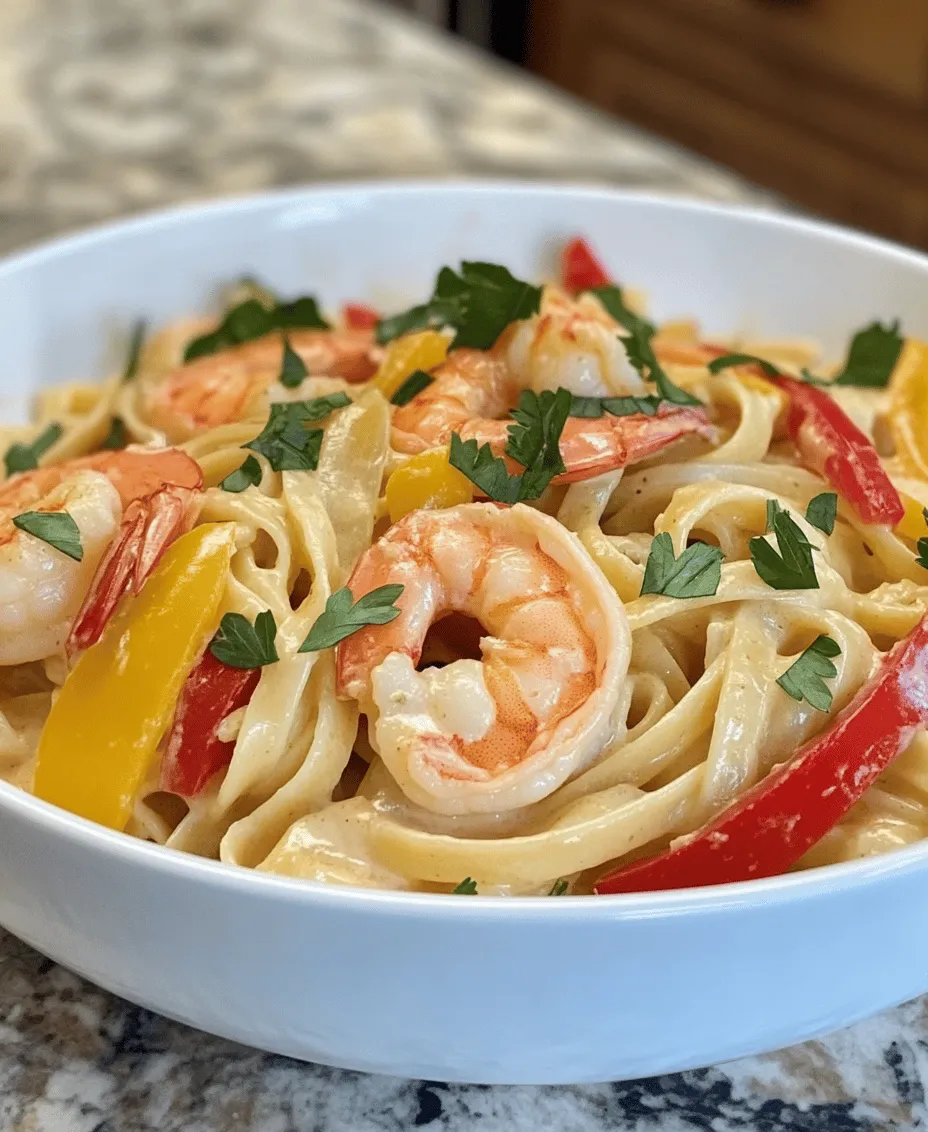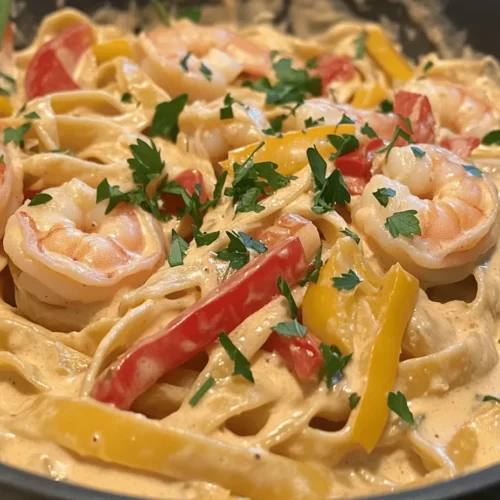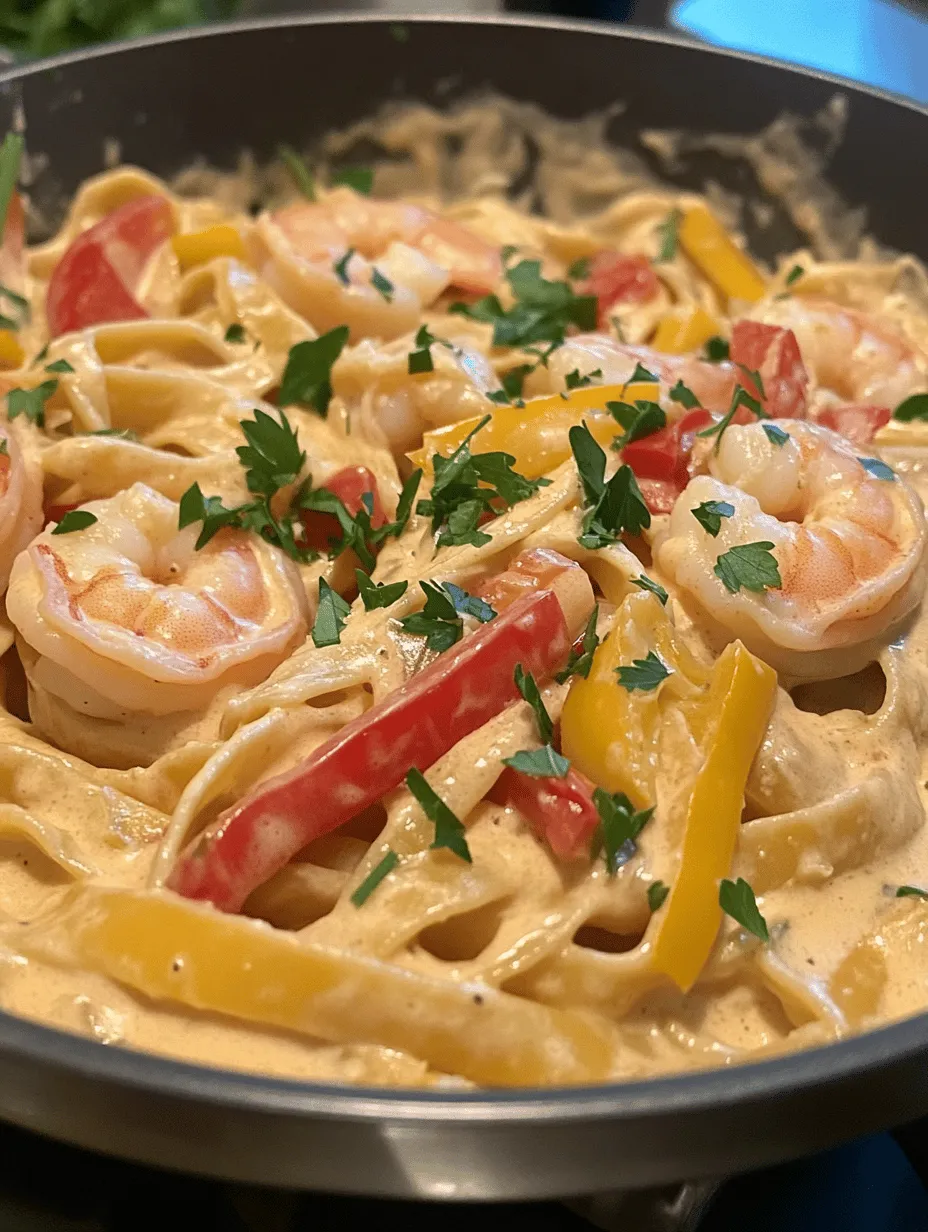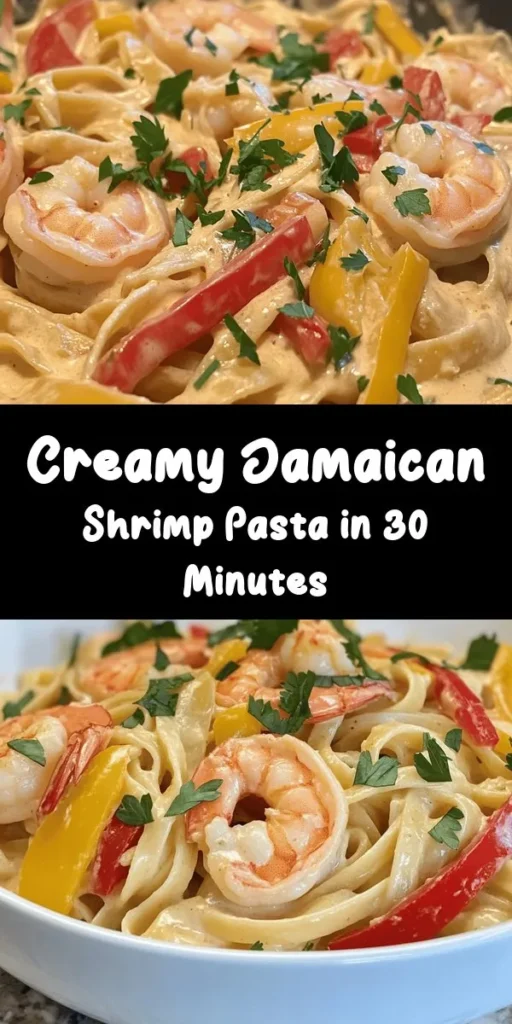Introduction
Jamaican cuisine is a vibrant tapestry of flavors, colors, and aromas that reflect the island’s rich cultural heritage. Known for its bold spices, fresh ingredients, and diverse influences ranging from African to Indian and European, Jamaican food offers a unique culinary experience that tantalizes the taste buds. One dish that beautifully embodies this fusion of flavors is Jamaican Shrimp Pasta—a delightful combination of Caribbean and Italian influences that invites you to indulge in a creamy, savory meal like no other.
Jamaican Shrimp Pasta is not just a mere combination of pasta and shrimp; it is a celebration of the island’s culinary spirit. The dish features fettuccine or linguine enveloped in a luxurious sauce made from rich coconut milk and infused with the fiery heat of Scotch bonnet pepper. The result is a creamy delight that balances spice and richness, making it a must-try for pasta lovers and culinary adventurers alike. Whether you are hosting a dinner party or looking for a comforting weeknight meal, this dish is sure to impress.
Creamy pasta dishes are beloved in many cuisines, and the unique twist of incorporating coconut milk provides a fresh and tropical flavor profile that sets Jamaican Shrimp Pasta apart from traditional Italian recipes. The warmth of the Scotch bonnet pepper adds a kick that can be adjusted to suit your palate, making this dish as versatile as it is delicious. In this article, we will explore the essential ingredients that make this recipe special, followed by detailed step-by-step instructions to help you create your own Jamaican Shrimp Pasta masterpiece.
Understanding the Ingredients
To create a truly authentic Jamaican Shrimp Pasta, it is crucial to understand the key ingredients that contribute to its unique flavor and texture. Each component plays a significant role in crafting the final dish, and knowing their origins and benefits will enhance your cooking experience.
Fettuccine or Linguine
Pasta is the foundation of this dish, and choosing the right type is essential. Fettuccine and linguine are both excellent options. Fettuccine is a flat, thick noodle that holds sauces well, making it ideal for creamy preparations. On the other hand, linguine is slightly thinner and has a more delicate texture, which can also complement the robustness of the sauce.
Originating from Italy, both types of pasta are versatile and can be used in a variety of dishes. When cooked to al dente perfection, they create a satisfying bite that enhances the overall eating experience. For this recipe, you can opt for either fettuccine or linguine, depending on your personal preference.
Large Shrimp
Shrimp is the star protein in this dish, and using large, succulent shrimp adds a delightful texture and flavor. Not only are shrimp delicious, but they are also packed with nutritional benefits. Rich in protein, low in calories, and a good source of essential nutrients such as selenium and vitamin B12, shrimp make for a healthy addition to your meal.
When sourcing shrimp, opt for sustainably caught varieties whenever possible. This not only supports responsible fishing practices but also ensures that you are getting the freshest seafood available. For the best results, look for shrimp that are firm to the touch and have a mild, ocean-like scent.
Coconut Milk
One of the defining features of Jamaican Shrimp Pasta is the use of coconut milk, which adds a creamy and slightly sweet element to the dish. Coconut milk is a staple in Caribbean cooking, often used in curries, soups, and sauces, providing richness and depth of flavor.
Beyond its delicious taste, coconut milk is also known for its health benefits. It contains medium-chain triglycerides (MCTs), which can help boost metabolism and provide energy. Additionally, coconut milk is lactose-free, making it an excellent alternative for those with dairy sensitivities.
Scotch Bonnet Pepper
No Jamaican dish would be complete without the infamous Scotch bonnet pepper. This small, brightly colored pepper packs a significant punch, known for its fruity flavor and intense heat. It is an essential ingredient in many Caribbean recipes, providing both spice and character.
When using Scotch bonnet peppers, it is important to handle them with care due to their heat levels. A little goes a long way, and you can adjust the amount to suit your spice tolerance. The pepper’s unique flavor complements the sweetness of coconut milk, creating a harmonious blend that is signature to Jamaican cuisine.
Fresh Herbs and Spices
Finally, the addition of fresh herbs and spices elevates the flavors of Jamaican Shrimp Pasta. Ingredients like garlic, onion, and bell peppers contribute aromatic depth, while fresh cilantro or parsley can add a burst of freshness. These ingredients not only enhance the dish’s flavor profile but also provide visual appeal with their vibrant colors.
Using fresh herbs and spices is key to achieving that authentic Caribbean taste. Dried herbs can be convenient, but they often lack the brightness and intensity that fresh ingredients provide. Be sure to chop your herbs just before adding them to the dish for maximum flavor.
Step-by-Step Cooking Instructions
Now that we’ve covered the essential ingredients, let’s dive into the step-by-step cooking instructions for your Jamaican Shrimp Pasta. This section will guide you through the process of creating this creamy delight, ensuring that you achieve the best results.
Cooking the Pasta
The first step in making Jamaican Shrimp Pasta is cooking the pasta to perfection. Whether you choose fettuccine or linguine, the cooking method remains the same.
1. Boil Water: Start by bringing a large pot of salted water to a rolling boil. The salt not only enhances the pasta’s flavor but also helps to season it during cooking.
2. Add Pasta: Once the water is boiling, add the pasta and cook according to the package instructions until al dente. Al dente pasta should be firm to the bite but not hard in the center, providing the perfect texture for your dish.
3. Reserve Pasta Water: Before draining the pasta, be sure to reserve about a cup of the pasta cooking water. This starchy water can be used later to adjust the consistency of your sauce, ensuring that it clings beautifully to the pasta.
4. Drain and Rinse: Drain the pasta in a colander and give it a quick rinse under cold water to stop the cooking process. Set it aside while you prepare the sauce.
Sautéing Aromatics
With the pasta cooking, it’s time to build the flavor base of your dish by sautéing aromatics.
1. Heat Oil: In a large skillet or sauté pan, heat a tablespoon of olive oil or butter over medium heat. The oil should shimmer, indicating that it is hot enough for cooking.
2. Add Garlic and Onion: Once the oil is ready, add minced garlic and diced onion to the pan. Sauté for about 2-3 minutes, stirring frequently, until the onion becomes translucent and fragrant. Be careful not to let the garlic burn, as it can turn bitter.
3. Aromatics are Key: The combination of garlic and onion is essential for building depth in your dish. Their sweetness will enhance the overall flavor and provide a comforting aroma that fills your kitchen.
Adding Vegetables
Next, it’s time to incorporate colorful vegetables that not only add flavor but also contribute texture and nutrition.
1. Introduce Bell Pepper: Add diced bell pepper to the skillet and sauté for another 3-4 minutes until they begin to soften. Bell peppers come in various colors—red, yellow, and green—each offering a slightly different sweetness and appeal.
2. Adjusting Spice Levels: Carefully add finely chopped Scotch bonnet pepper to the mix. Start with a small amount, and taste as you go to adjust the heat level to your preference. Remember that the pepper’s heat can intensify as it cooks, so moderation is key.
Cooking the Shrimp
The final step in this initial cooking phase is to add the shrimp, which will bring the dish together.
1. Add Shrimp: Once the vegetables are tender, push them to the sides of the skillet and add the large shrimp to the center. Cook for about 2-3 minutes on each side until they turn pink and opaque. Be mindful not to overcook the shrimp, as they can become rubbery.
2. Seasoning: As the shrimp cooks, season with salt, pepper, and any additional spices you desire. A sprinkle of paprika or a dash of cayenne pepper can enhance the flavor profile even further.
3. Combining Ingredients: Once the shrimp are cooked through, stir everything together in the pan to ensure that the flavors meld beautifully. This step is crucial to creating a cohesive dish that showcases the vibrant ingredients.
As we proceed to the next part of this recipe, you will learn how to create the luscious sauce that brings the Jamaican Shrimp Pasta together, making it a creamy delight that you and your guests will love. Stay tuned for the continuation of this flavorful journey!

Seasoning Tips to Enhance the Dish’s Caribbean Essence
To truly capture the vibrant spirit of the Caribbean in your Jamaican Shrimp Pasta, seasoning is key. The right blend of spices can elevate your dish from delicious to unforgettable. Start with salt and black pepper, which are foundational, but don’t stop there. Incorporate traditional Caribbean spices like allspice, known locally as pimento, which adds a warm, aromatic flavor. A touch of cayenne pepper or Scotch bonnet pepper brings the heat distinctive to Jamaican cuisine; adjust according to your spice tolerance.
Fresh garlic and ginger provide a zesty undertone, while dried thyme adds earthy notes that are quintessential in Caribbean cooking. Don’t forget the citrus! A splash of lime juice can brighten the entire dish and balance the richness of the cream. Finally, consider using a dash of soy sauce for umami depth, harmonizing beautifully with the shrimp’s natural sweetness.
Making the Sauce
The sauce is arguably the heart of your Jamaican Shrimp Pasta, combining the creamy richness of coconut milk and heavy cream. Begin by sautéing finely chopped onions, garlic, and ginger in olive oil until they are fragrant and translucent. This aromatic base is crucial for layering flavors. Once the vegetables have softened, it’s time to introduce your shrimp. Cook them until they turn pink, about 2-3 minutes.
Next, add the coconut milk, stirring gently to combine. Coconut milk is a staple in Caribbean cooking, offering a subtle sweetness that pairs perfectly with seafood. After the coconut milk is integrated, add the heavy cream to achieve a velvety texture. This balance between coconut milk and heavy cream creates a sauce that is rich but not overwhelmingly heavy, allowing the shrimp and pasta to shine.
The Balance Between Coconut Milk and Heavy Cream: Texture and Flavor
Finding the right ratio between coconut milk and heavy cream is essential for achieving the desired flavor and texture. A common ratio is 2 parts coconut milk to 1 part heavy cream, but this can be adjusted based on personal preference. Coconut milk lends a tropical sweetness and creamy consistency, while heavy cream adds luxurious richness. Together, they create a sauce that’s both light and indulgent, making every bite a delightful experience.
Cooking Techniques to Achieve the Desired Sauce Consistency
As you cook the sauce, it’s essential to maintain the right consistency. Start with medium heat to allow the flavors to meld without boiling away the liquid too quickly. If the sauce is too thick, you can add a little reserved pasta water to loosen it. Conversely, if it’s too thin, let it simmer gently, stirring occasionally, until it thickens to your liking. This technique not only ensures the sauce clings to the pasta perfectly but also enhances the overall flavor.
Combining Pasta and Sauce
Once your pasta is cooked al dente, it’s time to mix it with the sauce. Before draining, reserve about a cup of pasta water. This starchy water can be a lifesaver for adjusting the sauce’s consistency later on. Add the drained pasta directly to the sauce, tossing gently to combine. Use tongs or a pasta fork to lift the pasta and ensure it is evenly coated with the rich sauce.
Techniques for Mixing to Ensure Even Coverage of Sauce
To achieve an even coating, it’s important to gently fold the pasta into the sauce rather than stirring vigorously, which can break the pasta. Incorporate the pasta in batches if necessary, allowing each portion to absorb the sauce before adding more. This method ensures that every strand of pasta is enveloped in the creamy mixture, enhancing the dish’s overall enjoyment.
Adjusting Sauce Consistency with Reserved Pasta Water
If you find the sauce too thick after combining it with the pasta, don’t hesitate to add a splash of the reserved pasta water. This starchy liquid not only helps to thin the sauce but also binds it to the pasta, creating a cohesive dish. Start with a small amount, stir, and assess the consistency; you can always add more if needed.
Finishing Touches
The final touches to your Jamaican Shrimp Pasta are crucial for elevating the dish. Fresh ingredients like chopped parsley or cilantro add a pop of color and freshness that contrasts beautifully with the creamy sauce. A squeeze of fresh lime juice right before serving brightens the flavors and adds a refreshing zing.
For presentation, consider serving the pasta in wide, shallow bowls, garnished with additional herbs and lime wedges on the side. This not only enhances visual appeal but also invites everyone at the table to customize their flavor profile.
Nutritional Value of Jamaican Shrimp Pasta
Understanding the nutritional value of your meal can enhance your dining experience. A typical serving of Jamaican Shrimp Pasta contains approximately 500-600 calories, depending on the specific ingredients and portion size. The macronutrient breakdown is roughly 35% protein, 45% carbohydrates, and 20% fats, making it a balanced dish.
Shrimp is a lean protein source, rich in vitamins and minerals such as selenium and vitamin B12. Coconut milk, while higher in calories and fats, provides medium-chain triglycerides (MCTs) that can be beneficial for energy metabolism. When enjoying this dish, moderation is key; consider portion control, especially if you are mindful of calorie intake.
Cultural Significance of the Dish
Jamaican Shrimp Pasta is more than just a delicious meal; it represents the fusion of Caribbean and Italian cuisines, showcasing the rich cultural tapestry of Jamaica. The dish reflects the island’s historical context, where seafood has been a staple for centuries, heavily influenced by the availability of fresh catches and the diverse culinary practices brought by different cultures.
Caribbean cuisine is characterized by its vibrant flavors and use of local ingredients, while Italian cooking emphasizes simplicity and quality. The marriage of these two culinary traditions in Jamaican Shrimp Pasta exemplifies how food can transcend cultural boundaries, bringing together diverse influences to create something uniquely delightful.
Pairing Suggestions
To complement your Jamaican Shrimp Pasta, consider pairing it with a fresh green salad dressed with a light vinaigrette. This will provide a refreshing contrast to the creamy pasta. Grilled vegetables or garlic bread are also excellent options to serve alongside.
For beverages, traditional Caribbean drinks like a refreshing sorrel drink or a fruity rum punch can enhance the meal’s flavors. If you prefer wine, a chilled Sauvignon Blanc or a light-bodied Pinot Grigio pairs wonderfully with the shrimp and creamy sauce, balancing the richness and enhancing the overall dining experience.
Conclusion
Making and enjoying Jamaican Shrimp Pasta is a delightful culinary experience that brings together a medley of flavors and cultural influences. With its creamy sauce, perfectly cooked shrimp, and al dente pasta, this dish is sure to impress family and friends. As you explore more Caribbean-inspired recipes, remember that the joy of cooking lies not only in the process but also in sharing meals with loved ones. Embrace the flavors of the Caribbean, and let this dish transport you to sun-kissed shores as you enjoy every delicious bite.



